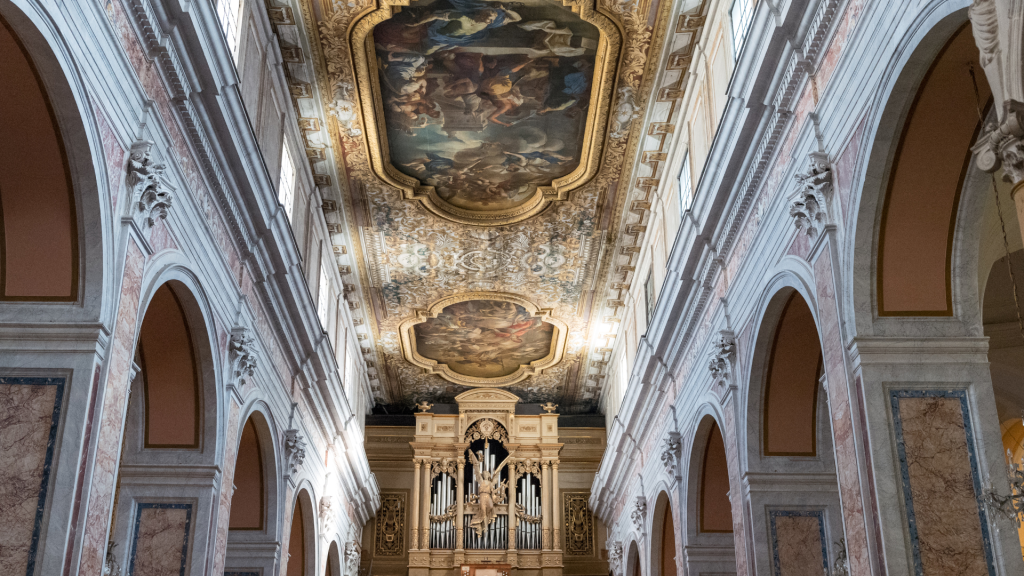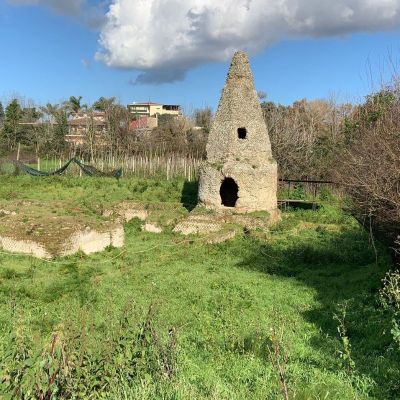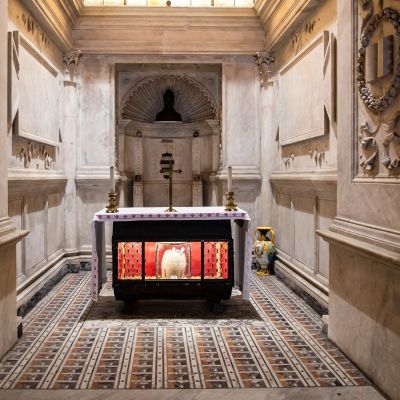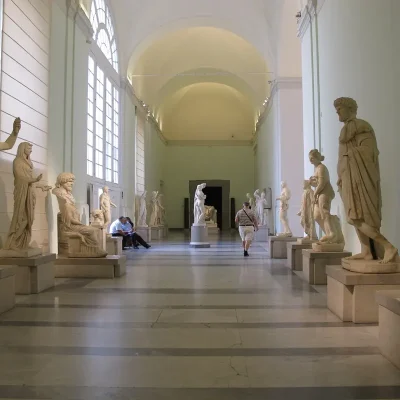Nestled in the heart of Sorrento, a picturesque town on Italy’s Amalfi Coast, stands a remarkable testament to religious architecture and art – The Cathedral of Sorrento. Known locally as the Duomo di Sorrento, this cathedral is not just a place of worship but a beacon of history, art, and culture, beckoning travelers from around the world to explore its storied halls. Whether you’re a history enthusiast, an art lover, or simply a curious traveler, the Cathedral of Sorrento offers a fascinating glimpse into the town’s rich past and vibrant present.
Historical Significance
The Cathedral of Sorrento’s roots date back to the 11th century, though much of its current form was shaped in the 15th century, with subsequent renovations over the centuries adding to its charm and complexity. Originally built on the ruins of a Roman temple, the cathedral stands as a living narrative of Sorrento’s evolution through the ages. It has been a silent witness to the town’s transformations, from a small Roman settlement to a bustling medieval town and now a popular tourist destination.
Architectural Marvel
Upon approaching the cathedral, visitors are greeted by a striking façade, a harmonious blend of Romanesque and Gothic styles, reflecting the various periods of its construction. The church’s exterior is adorned with a remarkable 14th-century bell tower, which houses an ancient bell, adding to the cathedral’s historical allure.

Stepping inside, the interior of the Cathedral of Sorrento reveals a nave and two aisles divided by pillars, showcasing a classic basilica layout. The cathedral’s interior is a blend of majesty and simplicity, with its high ceilings and spacious aisles evoking a sense of awe and reverence.
Artistic Treasures
The Cathedral of Sorrento houses an array of artistic treasures that are a delight for art aficionados. One of the highlights is the bishop’s throne, intricately carved from walnut wood, and dating back to the 16th century. The artistry and craftsmanship evident in the throne’s detailing are a testament to the skills of the local artisans of that era.
Another notable feature is the cathedral’s pulpit, adorned with beautiful mosaics that sparkle under the light, capturing the essence of religious art in Italy. Additionally, the cathedral boasts a collection of paintings and frescoes by notable Italian artists, each telling a unique story and adding layers of visual intrigue to the sacred space.
The Altar and Its Significance
The heart of the Cathedral of Sorrento is its altar, a magnificent piece of artistry in itself. The altar is home to a stunning 17th-century crucifix, revered not just for its religious significance but also for its artistic merit. Surrounding the altar are various chapels, each dedicated to different saints, and adorned with intricate decorations and artworks, offering a serene space for prayer and contemplation.
The Cultural Hub
Beyond its religious and artistic significance, the Cathedral of Sorrento serves as a cultural hub for the town.
It frequently hosts concerts, exhibitions, and community events, drawing both locals and tourists alike into its historic walls. The cathedral’s acoustics and ambiance make it an ideal venue for classical music performances, often featuring local and international musicians. These events provide an immersive cultural experience, allowing visitors to enjoy the arts within the setting of this historic monument.
A Glimpse into Local Life
For travelers seeking an authentic glimpse into the local life of Sorrento, a visit to the cathedral during a regular service can be enlightening. Observing the locals engaged in their traditions and rituals offers a deeper understanding and connection to the community and its heritage. It’s also an opportunity to experience the cathedral not just as a tourist site but as a living, breathing part of Sorrento’s daily life.
Preserving History
The Cathedral of Sorrento is not only a treasure trove of history and art but also a symbol of the town’s dedication to preserving its heritage. The ongoing maintenance and restoration efforts are testament to the community’s commitment to keeping this historic landmark alive for future generations to appreciate and explore.
Visitor Experience
For tourists visiting the cathedral, it’s recommended to take a guided tour to fully appreciate its history, architecture, and art. These tours often provide insights and anecdotes that are not immediately apparent, enriching the overall experience. Additionally, the cathedral’s central location in Sorrento makes it easily accessible and a perfect starting point for exploring the rest of the town.
Getting to the Cathedral of Sorrento
Before exploring the wonders of the Cathedral of Sorrento, it’s essential to understand the best ways to reach this historic site. Sorrento is accessible via various modes of transport, each offering a unique experience of the journey.
By Car: If you’re driving to Sorrento, the first signs to follow on the highway are those for Naples. Take the A3 towards the Sorrento Peninsula and exit at Castellammare di Stabia. From there, you’ll be on the SS145 Sorrentina, a scenic route that takes you through the major towns of the Peninsula: Vico Equense, Meta, Sant’Agnello, and finally Sorrento. The journey from Naples is approximately 44km and takes about 60 minutes under normal traffic conditions. During the summer months, be prepared for potential traffic delays.
By Train: The fastest and most economical way to reach Sorrento is by train. You’ll need a ticket to the Central Station of Naples Piazza Garibaldi, where trains from all over Italy arrive. By taking the stairs of the underpass upon exiting the station, you’ll reach the tracks of the Circumvesuviana train, with trains to Sorrento departing every 30 minutes. The journey takes about 60 minutes, and the train stops at all major towns of the Sorrento Peninsula. Tickets can be purchased at newsstands or the station’s ticket office.
By Air: To arrive in Sorrento by air, fly into Naples Capodichino, which is about 50 km from Sorrento and well-connected to major Italian and international locations. From the airport, the quickest and most convenient way to Sorrento is the Curreri bus line, which stops at every town on the Sorrento Peninsula and takes about 50 minutes. Many hotels in Sorrento offer (upon request) their own transfer services, and there are also various private transfer companies. Alternatively, taxis, buses, and shuttles connect to Naples’ main station (Piazza Garibaldi), from where you can take the Circumvesuviana train to Sorrento.
By Sea: For a scenic approach, consider reaching Sorrento by sea. Hydrofoils and ferries make the approximately 40-minute journey to Sorrento’s port. Though more expensive, this route offers a comfortable and picturesque travel experience. Once at the port, you can take a shuttle or walk the 300 meters to the town center, or use the elevator service.
Conclusion
The Cathedral of Sorrento is more than just a religious edifice; it’s a journey through time, art, and culture. Its walls narrate stories of past centuries, its art celebrates human creativity, and its role as a cultural hub connects the past with the present. For any traveler visiting Sorrento, the cathedral stands as a must-visit landmark, offering a unique blend of spiritual, artistic, and cultural enrichment. In the bustling streets of this charming Italian town, the Cathedral of Sorrento remains an enduring symbol of beauty, history, and community spirit.
Cattedrale SS. Filippo e Giacomo
Via Santa Maria della Pietà 44
80067 Sorrento (NA)
Tel/Fax: +39 081 878.22.48
Email: [email protected] – [email protected]
Discover More: “Discovering Sorrento: Things to Do in One Day“
After exploring the beauty of The Cathedral of Sorrento, if you’re keen to uncover more hidden gems and experiences in Sorrento, be sure to read our comprehensive guide, “Discovering Sorrento: Things to Do in One Day.” This extensive article is your perfect companion for making the most out of a day in this enchanting town.
In “Discovering Sorrento,” we delve into a curated selection of activities and sights that are ideal for a day trip. Whether you’re interested in historical sites, natural beauty, culinary delights, or shopping, our guide offers insightful recommendations to ensure your day in Sorrento is unforgettable.
From walking tours that reveal the town’s rich history to recommendations for the best local dining spots, “Discovering Sorrento” covers a range of interests and tastes. The guide also includes practical tips on navigating the town, helping you to plan your day efficiently and enjoyably.





